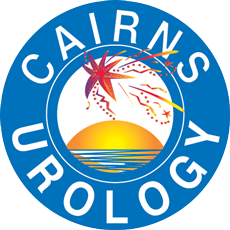




Radical Prostatectomy
The patient will have undergone a number of tests including a biopsy (sampling of prostate tissue examined under a microscope) to confirm the diagnosis.
Subsequent tests (staging) will have shown that there is no evidence of spread from the prostate gland to any other parts of the body.
The prostate is rather like a donut which is located at the opening of the bladder between the bladder and penis. The urine and sperm pass through the opening of the prostate gland and down the urethra (pipe) of the penis.
The seminal vesicles are two glands which store sperm at the base of the prostate gland underneath the opening of the bladder.
Both of the two seminal vesicles and the whole of the prostate gland are removed in this operation and the bladder is joined back onto the urethra to enable urine to drain out normally down through the penis.
The bladder is joined directly above the muscle which con-trols the patient's continence (ability to control urine).
Preparation for the Operation
X-Rays and scans must be brought to the hospital by the patient along with any medications which are taken regularly.
Aspirin should be stopped 7-10 days before hospital admission and no Aspirin containing products should be taken during that period of time.
An IV (drip) will be inserted into the patient's arm and the Anaesthetist will inject some medication which will put him to sleep.While he is asleep the Anaesthetist may insert an epidural anaesthetic in his back which will render him free from pain after the operation has taken place.
The operation is carried out either with a vertical or horizontal incision (cut) in the lower abdomen. At the end of the procedure, a catheter (tube) is placed through the penis and into the bladder to drain the urine and to enable healing to take place around it.
There may be drain tubes inserted into the abdominal wall to drain out any fluid or to stop a bruise forming internally.
It may be necessary to give blood transfusions. All donated blood is tested for such conditions as AIDS and Hepatitis and all care is given to ensure that no contaminated blood is ever given to a patient. Sometimes it is possible to (re-cycle the patient's) own blood.
If it is possible during the surgery the surgeon will try and preserve the nerves and blood vessels which cause an erection, however it may not be possible to preserve those and completely remove the cancer and therefore it is possible that the patient may become impotent afterwards (lose erections).
Post Operative Care
When the patient returns to the ward he will not be able to have anything to eat or drink until he is wide awake.
The IV will continue to run until he is drinking satis-factorily and may have to run longer if intravenous antibiotics or other medications are required.
If an epidural has been inserted then it will be adjusted to give him adequate pain relief.
It will be necessary for him to take deep breaths and cough every hour and to move his legs for 5 minutes each half hour in a manner akin to peddling a bike.
Each day he will be asked to do more in the way of mobilising until he does not require assistance.
The wound will have been closed with stitches or staples which are usually removed within 7 to 10 days of the operation. The patient is usually discharged home between 4-10 days after the operation.
He may be discharged home with the catheter in place for a period of up to 3 weeks. That is to enable healing to take place. The urine will drain into a small bag attached to his leg which no one will be able to see under his clothing.
Discharge from Hospital
The patient will find that he tires easily and is significantly weaker because of the procedure he has have undergone. This is temporary.
The patient may have showers and take regular walks which will help him improve. The patient may find that it takes at least 6 weeks before he starts to feel significantly better.
Problems That Should Be Reported:
1 Fever over 38 C
2 Heavy bleeding or clots.
3 Catheter has stopped draining or falls out.
It is normal to see some blood in the urine for a number of weeks after the procedure. Should the colour of the urine be darker than a rosé then then the patient should rest and increase his fluid intake for the remainder of that day.
He may find the bleeding increases after the bowels have moved. That is normal and he should consume a further drink in order to wash it away.
The catheter bags should be emptied before they get too full.
Exercise
Patients are encouraged to walk and gradually resume their normal exercise after Radical Prostatectomy.
The patient should not drive a car for at least two weeks after surgery for two reasons. The first is that healing is taking place and any sudden action required may cause disruption of the wound. Secondly, if he has pain or discomfort he may not be able to respond to an emergency at an appropriate speed and he therefore may not be able to avoid a tragedy.
He should not go on long car trips but if absolutely necessary, should stop at least once every hour for at least ten minutes to walk around and have a drink.
Follow Up
The Surgeon will advise the patient regarding the long term follow-up after his procedure.
